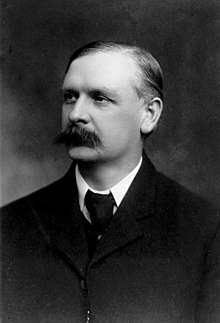Leonard Hill (physiologist)
Sir Leonard Erskine Hill | |
|---|---|
 Sir L.E. Hill. Credit:Wellcome Library | |
| Born | (1866-06-02)2 June 1866 |
| Died | 30 March 1952(1952-03-30) (aged 85) |
| Nationality | British |
| Alma mater | Haileybury College, University College, London |
| Scientific career | |
| Fields | Medicine, Physiology |
Sir Leonard Erskine Hill FRS[1] (2 June 1866, in Bruce Castle, Tottenham – 30 March 1952, in Corton, Suffolk) was a British physiologist.[2][3] He was elected a Fellow of the Royal Society in 1900[1] and was knighted in 1930. One of his sons was the epidemiologist and statistician Austin Bradford Hill. His father was George Birkbeck Hill, the famous scholar and commentator on the works of Samuel Johnson, who at the time of his birth was headmaster of Bruce Castle School.
Education
[edit]Sir Leonard Erskine Hill attended Haileybury College. He later received his MB from University College, London in 1890.[2] In 1931, he received an honorary LLD from the University of Aberdeen.[2]
Medicine
[edit]Hill's work on blood pressure led him to believe "the arterial pressure can be taken in man as rapidly, simply, and accurately as the temperature can be taken with the clinical thermometer".[2] This work developed into the Hill's sign.[2][4] Hill was the second recipient of the T. K. Sidey Medal, set up by the Royal Society of New Zealand as an award for outstanding scientific research.[5][6][7]
Hill was an advocate of light therapy and in 1924 authored Sunshine and Open Air: Their Influence on Health.[8]
Diving medicine
[edit]Hill performed research into decompression sickness, oxygen toxicity, and effects of carbon dioxide in diving.[2][3][9]
Hill advocated linear or uniform decompression profiles.[3][9] This type of decompression is used today by saturation divers. His work was financed by Augustus Siebe and the Siebe Gorman Company.[3]
Personal life
[edit]
Hill married Janet Alexander in 1891, and they had six children.[2] In 1904, he took an extended leave of absence due to tuberculosis.[2] Hill died of a cerebral thrombosis in 1952.[2]
Hill was a distinguished watercolourist and also wrote children's stories. He was fond of the outdoor life, and went every day to bathe in a pond in Epping Forest at Loughton where he lived. He later moved to Hampstead.
Selected publications
[edit]- A Textbook of Physiology (with Martin William Flack, 1919)
- The Science of Ventilation and Open Air Treatment (1919)
- Sunshine and Open Air: Their Influence on Health (1924)
- Health and Environment (with Argyll Campbell, 1925)
- Philosophy of a Biologist (1930)
- Manual of Human Physiology (1935)
See also
[edit]- Decompression (diving) – Pressure reduction and its effects during ascent from depth
References
[edit]- ^ a b Douglas, C. G. (1953). "Leonard Erskine Hill. 1866-1952". Obituary Notices of Fellows of the Royal Society. 8 (22): 431–443. doi:10.1098/rsbm.1953.0009. JSTOR 769221. S2CID 37691201.
- ^ a b c d e f g h i Hill, A. B.; Hill, B. (1968). "The life of Sir Leonard Erskine Hill FRS (1866–1952)". Proceedings of the Royal Society of Medicine. 61 (3): 307–316. doi:10.1177/003591576806100350. PMC 1902312. PMID 4868973.
- ^ a b c d Acott, C. (1999). "JS Haldane, JBS Haldane, L Hill, and A Siebe: A brief resume of their lives". South Pacific Underwater Medicine Society Journal. 29 (3). ISSN 0813-1988. OCLC 16986801. Archived from the original on 27 July 2011. Retrieved 12 July 2008.
- ^ Hill, L.; Barnard, H.; Sequeira, J. H. (1897). "The Effect of Venous Pressure on the Pulse". The Journal of Physiology. 21 (2–3): 147–159. doi:10.1113/jphysiol.1897.sp000648. PMC 1512990. PMID 16992380.
- ^ "Background of the Medal". Royal Society of New Zealand. Retrieved 7 August 2015.
- ^ "Recipients". Royal Society of New Zealand. Retrieved 7 August 2015.
- ^ "Sidey Medal Winner". Auckland Star. Vol. LXVII, no. 280. 25 November 1936. p. 16. Retrieved 7 August 2015.
- ^ "Sunshine and Open Air: their Influence on Health, with special reference to the Alpine Climate". Nature. 115 (2886): 259. 1925. doi:10.1038/115259c0. S2CID 13098690.
- ^ a b Hill, L (1912). Caisson sickness, and the physiology of work in compressed air. London E. Arnold. Retrieved 16 December 2008.
Leonard Erskine Hill.
External links
[edit] Works by or about Leonard Erskine Hill at Wikisource
Works by or about Leonard Erskine Hill at Wikisource- Chris Pond, The Buildings of Loughton and Notable people of the town [rev ed.2010]
- Royal Society election certificate
| International | |
|---|---|
| National | |
| People | |
| Other | |
